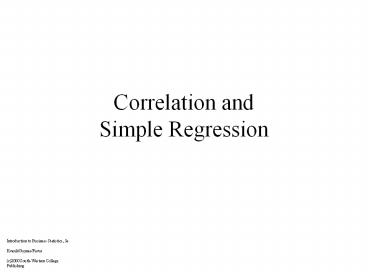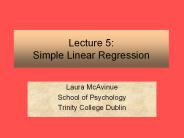Correlation and Simple Regression - PowerPoint PPT Presentation
Title:
Correlation and Simple Regression
Description:
Correlation and Simple Regression Introduction to Business Statistics, 5e Kvanli/Guynes/Pavur (c)2000 South-Western College Publishing – PowerPoint PPT presentation
Number of Views:181
Avg rating:3.0/5.0
Title: Correlation and Simple Regression
1
Correlation andSimple Regression
Introduction to Business Statistics, 5e
Kvanli/Guynes/Pavur (c)2000 South-Western
College Publishing
2
Bivariate Data
Figure 14.1
X family Income Y square footage of their home
Introduction to Business Statistics, 5e
Kvanli/Guynes/Pavur (c)2000 South-Western
College Publishing
3
Coefficient of Correlation
- The sample coefficient of correlation, r,
measures the strength of the linear relationship
that exists within a sample of n bivariate data.
Introduction to Business Statistics, 5e
Kvanli/Guynes/Pavur (c)2000 South-Western
College Publishing
4
Coefficient of Correlation Value
Introduction to Business Statistics, 5e
Kvanli/Guynes/Pavur (c)2000 South-Western
College Publishing
5
Coefficient of Correlation Properties
- r ranges from -1.0 to 1.0.
- The larger r is, the stronger the linear
relationship. - r near zero indicates that there is no linear
relationship. X and Y are uncorrelated. - r 1 or -1 implies that a perfect linear pattern
exists between the two variables.
Introduction to Business Statistics, 5e
Kvanli/Guynes/Pavur (c)2000 South-Western
College Publishing
6
Coefficient of Correlation Properties
- The sign of r tells you whether the relationship
between X and Y is a positive (direct) or a
negative (inverse) relationship. - The value of r tells you very little about the
slope of the line. Except if the sign of r is
positive the slope of the line is positive and if
r is negative then the slope is negative.
Introduction to Business Statistics, 5e
Kvanli/Guynes/Pavur (c)2000 South-Western
College Publishing
7
Various Values of r
Figure 14.2
Introduction to Business Statistics, 5e
Kvanli/Guynes/Pavur (c)2000 South-Western
College Publishing
8
Covariance
- The sample covariance between two variables,
cov(X,Y) is a measure of the joint variation of
the two variables X and Y and is defined to be
Introduction to Business Statistics, 5e
Kvanli/Guynes/Pavur (c)2000 South-Western
College Publishing
9
Least Squares Line
- The least squares line is the line through the
data that minimizes the sum of the differences
between the observations and the line. ?d2
d12 d22 d32 dn2
Introduction to Business Statistics, 5e
Kvanli/Guynes/Pavur (c)2000 South-Western
College Publishing
10
Least Squares Line
Figure 14.6
Introduction to Business Statistics, 5e
Kvanli/Guynes/Pavur (c)2000 South-Western
College Publishing
11
Sum of Squares of Error
2
ˆ
å
(
y
-
y
)
?d2 SSE
Introduction to Business Statistics, 5e
Kvanli/Guynes/Pavur (c)2000 South-Western
College Publishing
12
Assumptions for the Simple Regression Model
- The mean of each error component is zero.
- Each error component (random variable) follows an
approximate normal distribution. - The variance of the error component is the same
for each value of X. - The errors are independent of each other.
Introduction to Business Statistics, 5e
Kvanli/Guynes/Pavur (c)2000 South-Western
College Publishing
13
Simple Linear Regression Model Assumptions
Introduction to Business Statistics, 5e
Kvanli/Guynes/Pavur (c)2000 South-Western
College Publishing
Figure 14.10
14
Hypothesis Test on theSlope of the Regression
Line
Ho ?1 0 (X provides no information) Ha
?1 ? 0 (X does provide information)
Introduction to Business Statistics, 5e
Kvanli/Guynes/Pavur (c)2000 South-Western
College Publishing
Figure 14.11
15
Hypothesis Test on theSlope of the Regression
Line
Ho ?1 0 Ha ?1 ? 0
Reject Ho if t gt t?, n-2
Introduction to Business Statistics, 5e
Kvanli/Guynes/Pavur (c)2000 South-Western
College Publishing
16
(1- ?) 100 Confidence Interval for ?1
Introduction to Business Statistics, 5e
Kvanli/Guynes/Pavur (c)2000 South-Western
College Publishing
17
Measuring the Strength of the Model
SCP
XY
b
1
SS
X
Introduction to Business Statistics, 5e
Kvanli/Guynes/Pavur (c)2000 South-Western
College Publishing
18
Hypothesis Test to Determine the Significance of
the Model
Ho ?1 0 (no linear relationship exists) Ha
?1 ? 0 ( a linear relationship exists)
Reject Ho if t gt t?, n-2
Introduction to Business Statistics, 5e
Kvanli/Guynes/Pavur (c)2000 South-Western
College Publishing
19
Coefficient of Determination
Introduction to Business Statistics, 5e
Kvanli/Guynes/Pavur (c)2000 South-Western
College Publishing
20
Total Variation
Introduction to Business Statistics, 5e
Kvanli/Guynes/Pavur (c)2000 South-Western
College Publishing
Figure 14.18
21
(1- ?) 100 Confidence Interval for ? yx
Introduction to Business Statistics, 5e
Kvanli/Guynes/Pavur (c)2000 South-Western
College Publishing
22
Prediction Interval for YXo
Introduction to Business Statistics, 5e
Kvanli/Guynes/Pavur (c)2000 South-Western
College Publishing
23
Checking Model Assumptions
Introduction to Business Statistics, 5e
Kvanli/Guynes/Pavur (c)2000 South-Western
College Publishing
Figure 14.22
24
Checking Model Assumptions
Introduction to Business Statistics, 5e
Kvanli/Guynes/Pavur (c)2000 South-Western
College Publishing
Figure 14.23





![DOWNLOAD [PDF] Correlation and Regression: Applications for Industrial PowerPoint PPT Presentation](https://s3.amazonaws.com/images.powershow.com/10076646.th0.jpg?_=20240711041)

























